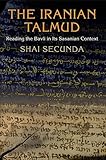The Iranian Talmud : Reading the Bavli in Its Sasanian Context / Shai Secunda.
Material type: TextSeries: Divinations: Rereading Late Ancient ReligionPublisher: Philadelphia : University of Pennsylvania Press, [2013]Copyright date: ©2014Description: 1 online resource (272 p.)Content type:
TextSeries: Divinations: Rereading Late Ancient ReligionPublisher: Philadelphia : University of Pennsylvania Press, [2013]Copyright date: ©2014Description: 1 online resource (272 p.)Content type: - 9780812245707
- 9780812209044
- BM501 .S27 2014
- online - DeGruyter
- Issued also in print.
| Item type | Current library | Call number | URL | Status | Notes | Barcode | |
|---|---|---|---|---|---|---|---|
 eBook
eBook
|
Biblioteca "Angelicum" Pont. Univ. S.Tommaso d'Aquino Nuvola online | online - DeGruyter (Browse shelf(Opens below)) | Online access | Not for loan (Accesso limitato) | Accesso per gli utenti autorizzati / Access for authorized users | (dgr)9780812209044 |
Frontmatter -- Contents -- Note on abbreviations, citations, and terminology -- Introduction -- Chapter 1. The Sea of Talmud and Its Shore -- Chapter 2. In the Temple and Synagogue -- Chapter 3. Constructing "Them" -- Chapter 4. Closer Than They May Appear -- Chapter 5. In Iran -- In Lieu of a Conclusion -- Notes -- Bibliography -- General Index -- Source Index -- Acknowledgments
restricted access online access with authorization star
http://purl.org/coar/access_right/c_16ec
Although the Babylonian Talmud, or Bavli, has been a text central and vital to the Jewish canon since the Middle Ages, the context in which it was produced has been poorly understood. Delving deep into Sasanian material culture and literary remains, Shai Secunda pieces together the dynamic world of late antique Iran, providing an unprecedented and accessible overview of the world that shaped the Bavli.Secunda unites the fields of Talmudic scholarship with Old Iranian studies to enable a fresh look at the heterogeneous religious and ethnic communities of pre-Islamic Iran. He analyzes the intercultural dynamics between the Jews and their Persian Zoroastrian neighbors, exploring the complex processes and modes of discourse through which these groups came into contact and considering the ways in which rabbis and Zoroastrian priests perceived one another. Placing the Bavli and examples of Middle Persian literature side by side, the Zoroastrian traces in the former and the discursive and Talmudic qualities of the latter become evident. The Iranian Talmud introduces a substantial and essential shift in the field, setting the stage for further Irano-Talmudic research.
Issued also in print.
Mode of access: Internet via World Wide Web.
In English.
Description based on online resource; title from PDF title page (publisher's Web site, viewed 30. Aug 2021)


